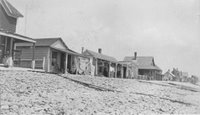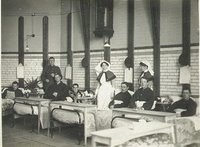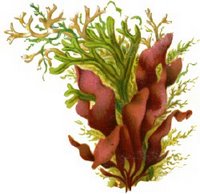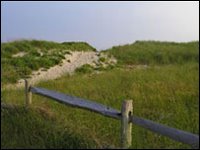 Preparations for our annual trek to Aunt Mary’s seaside cottage usually began around early April. That’s when the backyard was fairly free of mud, and the laundry could once again, after the long New England winter, be hung on the clotheslines. The first step in the preparations was called the “airing.”
Preparations for our annual trek to Aunt Mary’s seaside cottage usually began around early April. That’s when the backyard was fairly free of mud, and the laundry could once again, after the long New England winter, be hung on the clotheslines. The first step in the preparations was called the “airing.”Remembering the exodus from the beach house the previous September, when everything was washed, folded, wrapped in tissue and then in old percale sheets, it seemed a waste of time to me to then, the next spring, remove everything from the old wicker hampers, unfold it, carry great baskets of linens down the treacherous attic stairs, trudge to the clothes yard, hang it all up with new, clean clothespins, air it, take down, fold it, wrap it in new tissue, and replace it in the hampers.
The answer, of course, was that Aunt Mary was a nurse, a pediatric nurse to boot, and could not tolerate the slightest hint of must or the tiniest speck of mildew. She herself was, despite being about 100 pounds overweight, impeccable, she smelled wonderful, like violet soap, or the lavender sachets she placed amongst the linens.
There were four large hampers. Aunt Mary’s domain was the west wall of our attic, and boxes, barrels, hampers, garment bags and galvanized trashcans went from wall to wall, floor to ceiling. That space, I figured, was almost as large as the entire beach house – so where did we put it all in those tiny rooms, in those magical months of summer?
Hamper #1 held sheets, pillowcases and cotton blankets. Hamper #2 was filled with beach towels, bathing caps, and assorted old bathing suits and shorts, plus gear for swimming, swim fins, and Noxzema, Unguentine, and Asorbine Jr. for sunburns. Hamper #3 produced all the table linens, placemats, napkins and silverware. Salt cellars and pepper shakers. Lots of paper bowls and plates for clambakes. Nutcrackers for lobsters and some wonderful cotton bibs, probably made by my mother, particularly for clam and lobster feasts. Hamper #4 was saved for Aunt Mary’s clothing, stuff she didn’t wear when ”on duty” as a nurse. There were striped seersucker dresses (voluminous, sewn by my mother); white duck hats, an assortment of sneakers and canvas beach shows; a large variety of aprons (also sewn by mother) – no one cooked or cleaned without an apron over their dress. There were also several windbreakers, khaki in color, for sitting on the beach. I never saw Aunt Mary wearing a sweater.
In the other barrels, crates, and boxes were footstuffs and canned goods, saved from the previous summer. There were ointments and shampoos, nail clippers, hair curlers, and bobby pins. Emergency medical kits with Band-Aids, gauze pads, adhesive tape, bug spray, spirits of ammonia, Pepto Bismol and Castoria (one of my favorites – what a lovely taste!). There was mint-flavored castor oil. There was Blue Gentian just in case someone got impetigo. Beached, as it were, and Aunt Mary without transportation once she arrived at the shore with her horde, we were a pharmaceutical phantasmagoria.
We. Her summer brood was composed of US – myself, my younger brother, and various assorted cousins. Occasionally the privileged children she nursed in Boston. More occasionally the underprivileged children she happened to come across in her nursing duties. Rarely, a child of one of my father’s farm hands. It was, I know now, an eclectic group. Adults were not the top priority, though Aunt Mary depended on them for transportation, weekend camaraderie, and fraternal sharing. Aunt was one of fifteen children, my father being a younger brother. She lived with our family, off and on, in between nursing stints, and therefore had the grand attic space, my mother as seamstress, and a ready-made brood of chicks to nurture every summer. Warm, gigantic, cozy, and meticulously demanding in her discipline; unmarried, childless, and needy of caretaking, she was our Mother Goose, our Camp Leader, our escape from the confines of the farm.
Word has it, my grandfather was a salesman for S. S. Pierce, that wonderful commissary of food in Boston. So it was natural that Aunt Mary would stock up for our summers at that very store. “Stock up” is a mild phrase. Around early June a truck would arrive with enough stuff to supply a restaurant. Cases and cases of tinned plums, peaches, pears, soups and bisques, jams and jellies and condiments. This supply, of course, would be a back-up in case of bad weather or no one arriving to drive us to the store. Otherwise, once we got to the beach house, there was a fishmonger, a bread man, and various family members who would trek down with hand baskets filled with fresh vegetables and fruits from the farm. My mother was also commissioned to, at least once a week, bake apple and blueberry pies, baking powder biscuits, and a wondrous assortment of cookies. Of course, Cushman’s Bakery might not get through to provide us with the needed cupcakes, jelly rolls, Danish pastries and coconut cakes that we required after a full day of swimming and playing.
Leaving the farm was the Caravan. My father’s Woodie beach wagon. My Uncle Luke’s truck. My Aunt Ruth’s coupe (which boasted a rumble seat, and was therefore not a great transport.) The morning of the leave was the most exciting part, with everyone lined up in front of our farmhouse and a posse of stalwarts to load all the vehicles.
There was always a bit of argument as to the route. If we went down the East Beach Road, we could stop on Route 6 for more supplies, and we would be able to smell the delectable honeysuckle that dripped over the roadside. If we went through Westport Point, we could stop at Lee’s and pick up a slab of fresh swordfish for our first supper. Going through Central Village afforded a stop at Perry’s Farm Stand where we might just find vegetables that we’d forgotten to bring. Whatever the chosen route, the Caravan left about 10 AM and arrived at the Beach House around noon, everything safe and sound, having been as meticulously packed as if by a professional mover, covered with canvas and roped down.
Then began the unpacking and settling, everyone choosing their pine bunk, racing around with boxes, peeking into all the cupboards to see if the same pink and white dishes were here, filling a dishpan with water and placing it on the porch to rinse off sandy feet after our first swim of the season. The red, yellow, and green wooden surfboards were deposited on the front porch. Foodstuffs were put in the beach closet to keep cool. Aunt Mary’s hampers were put in the back bedroom, which boasted bunk beds and gave plenty of storage space. She never slept there. There was never any room. To the best of my memory, she always slept on the living room couch, just at the bottom of the stairs leading to the second floor bedrooms. Perhaps she felt she could hear the children better that way.
Blue and yellow Fiesta bowls were placed on the mantel. In one went a supply of Teaberry, Juicy Fruit, and Wrigley’s Spearmint gum. In another went Hershey’s Kisses and Sugar Daddies. Those were considered forbidden. They were snacks for good children who did their morning chores.
So ends my little tale of getting to Horseneck Beach. May many other children be as fortunate as I to have as plump and wondrously disciplined auntie as Aunt Mamie I.












